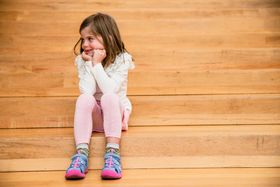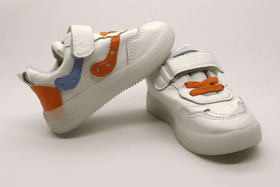Top 4 Tips for Breaking in New Kids Shoes
Breaking in new shoes doesn't have to be a painful, time-consuming chore. With our expert tips, you can make the wear-in process quick, comfortable, and even fun.
Updated December 6, 2024.

Children's feet grow quickly, so you need to ensure their shoes fit well and are comfortable. Ill-fitting shoes can lead to pain, injuries, and even long-term foot problems. By taking the time to break in new shoes, you can help reduce the risk of these issues and keep your child's feet healthy and happy.
With a little patience and the right techniques, you can simplify the process of breaking in new shoes. Here are our top four tips to help you get started.
» Browse our selection of orthopaedic children's shoes
1. Get the Perfect Fit
A good fit means happy feet—during the wear-in process and after. So, when buying shoes for your kid, head to a store with staff who can measure your little one's feet and help you find the perfect pair of shoes.
Experts say to leave some wiggle room—about half a size bigger than your kid's current size. But don't go too big, or the shoes will be uncomfortable and might even cause accidents.
» Discover more about the effects of improperly sized shoes on children
Youngsters grow fast, so you might need a quick fix from time to time if their shoes start feeling snug. Until you can buy a new pair, you can try insoles or even stretch the shoes a little.
» Learn how to choose kids' shoes for different stages of foot development
2. Choose the Right Socks and Insoles
Socks matter too. Opt for thinner socks to ensure your kid's shoes fit just right. Thicker socks can make shoes feel tighter and less comfortable, which may lead to blisters or other foot problems.
» Say goodbye to squeezed feet with these 10 best wide shoes for kids
Generally, sports socks or other shorter styles work well. They don't bunch up and help keep the focus on the shoe's fit.
Insoles can also make shoes more comfortable and help with posture, but if they're too thick, they can make the shoes feel too constricting. If you're unsure which insoles to choose, consult your child's doctor for personalized recommendations.
» Check out these shoes with removable insoles
3. Break the Shoes in at Home First
Before your child wears their new shoes outside, have them break the shoes in at home. This reduces the chance of cuts, trips, or other injuries.
Start by having your kiddo wear the shoes for short periods, like an hour or two at a time. Let them walk around the house and do their normal activities. This will help them get used to the feel of the new shoes in a safe place.
After a few days, you can gradually increase the wearing time. Let your child wear the shoes for longer periods while playing or adventuring at home. Once they feel comfortable, you can take your little one on short walks around the block or to the park.
» Use this guide to help your little one walk on their own
Most shoes will naturally break in after a few weeks of regular wear. Usually, three to four weeks is enough. But every child is different, so be patient. If your child says the shoes hurt or don't feel right, take a break and try again later.
» Learn how to handle shoe allergies in children
4. Try Different Stretching Techniques
If you need to break in your child's shoes quickly, try these stretching techniques:
Bend the Toe Area
If the toe box feels tight, gently bend it back and forth to increase flexibility. Apply pressure with your hands, focusing on the areas that need stretching. But don't overdo it—excessive bending could damage the shoe or cause creases. You can also do this for the heel or any other part of the shoe that needs more space.
» Discover different ways to keep your child's feet happy and healthy
Use Heat
Carefully apply heat from a hairdryer to make the shoes more malleable. Follow these steps:
- Use the dryer on the low heat setting.
- Hold it about six inches away from the shoe, and keep it moving to avoid overheating any one area.
- Focus on the tight spots, like the toe box or heel.
- Heat the area for no more than 20 to 30 seconds at a time.
- Feel the material frequently—it should warm up, not become uncomfortably hot.
- Put socks on your child's feet and then the shoes.
- Let the shoes cool completely while your child wears them to allow the material to mould to their feet.
Note: Be cautious not to use heat for too long. It can melt parts of the shoe and cause permanent damage, which could potentially hurt your child.
Try Ice
Fill a sealable plastic bag with water and place it inside the shoe. Then, put the shoe with the water bag in the freezer for about four to six hours. As the water freezes and expands, it will gently stretch the shoe material.
Once you remove the shoe from the freezer, let it thaw for a bit before removing the bag.
Take out the bag completely before letting your child wear the shoes—any leftover ice could cause discomfort or wet socks.
Invest in Shoe Stretchers
These tools can stretch shoes in specific areas, like the toe box or instep. They come in various sizes and can be adjusted to fit your child's shoe. Insert the stretcher into the shoe and tweak it to apply pressure to the tight areas. For best results, leave the stretcher in place for at least 24 hours.
Note: Follow the manufacturer's instructions for proper use and avoid over-stretching the shoes.
Squeeze the Heel
For some shoes—especially those with a softer heel counter—gently squeezing the back of the heel can help soften the material. Place your thumb inside the heel and your fingers on the outside, then apply pressure. (Repeat this process a few times.) This can help make the heel area more flexible and comfortable.
However, this strategy's effectiveness depends on the shoe's quality and construction. Some materials may not respond well to this technique.
» Find out which shoe fabrics are best for your kid's feet
While these techniques can help, it's always best to start with a properly fitted shoe. If you frequently need to stretch your child's shoes, it may be a sign that they need a different size or style.
» Make sure you know when to replace your child's shoes
5. Actively Engage Your Kid in the Process
Make breaking in new shoes a fun and engaging experience for your child. Encourage them to participate in various exercises and games that can help stretch and soften the shoes, like:
- Star jumps and skipping: These high-energy activities can help flex the shoes and make them more comfortable.
- Running and walking: Have your child wear the shoes while doing basic exercises like running and walking. These movements will help the shoes conform to their feet.
- Toe bends and stretches: Guide your child to bend their toes and stretch their feet using their hands. This can help loosen up tight areas in the shoes.
- Foot circles: Ask your youngster to make circular motions with their feet while wearing the shoes. This helps stretch the shoe material and improve flexibility.
- Stair exercises: Encourage your kid to walk up and down stairs while wearing the new shoes. This helps stretch and strengthen the feet and ankles.
Note: You can use plasters on areas prone to rubbing to prevent blisters and discomfort.
» Ensure support and comfort during playtime with our best shock-absorbing shoes for kids
Help Your Child Put Their Best Foot Forward
Breaking in new shoes is essential for ensuring your child's comfort and foot health. By following these four tips, you can help make the process smoother and more enjoyable for your little one.
But remember, every child is unique, and what works for one may not work for another. Pay attention to your child's feedback and adjust your approach as needed. If you're ever unsure about the fit or comfort of your child's shoes, don't hesitate to seek advice from a professional, like a podiatrist or experienced shoe store staff.
» Foster healthy foot development with our range of breathable, comfy, and supportive footwear





